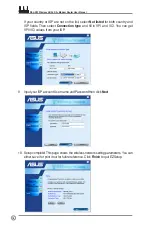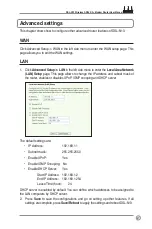
DSL-N13 Wireless ADSL 2/2+ Modem Router User Manual
22
WPA:
WPA stands for WiFi-Protected Access. WPA provides two security
modes for Home/SOHO user and enterprise network. The former
solution adopts Pre-Shared Key for authentication, and the later uses the
existing 802.1X RADIUS server in the enterprise network to process the
authentication requests.
WPA - PSK:
WPA-PSK (Pre-Shared Key) is the solution for home and SOHO users
who have no 802.11X authentication server within the LAN. To setup
WPA-PSK, you need to input a passphrase and let the system generate
the key. Combination of letters, numbers and non-alphnumeric charecters
is recommended for ensuring security.
Encryption
Encryption is used to convert plain text data into unreadable codes with certain type of
algorithm before capsulation for wireless transmission. DSL-N13 supports the following
encryption methods:
WEP:
WEP stands for Wired Equivalent Privacy. It uses 64 or 128-bit static
keys. You can let the system generate the WEP keys by inputting a
Passphrase.
TKIP:
Temporal Key Integrity Protocol (TKIP) dynamically generates unique
keys to encypt every data packet in a wireless session.
AES:
Advanced Encryption Standard (AES) is a dependable encryption
adopted in WPA2 or IEEE802.11i standard. It offers stronger protection
and greatly increases the complexity of wireless encryption.
TKIP + AES:
For a network where WPA clients (using TKIP encryption) and WPA2
clients (using AES encryption) co-exit. Select this option to enable both.
How to setup wireless security
Open
1. Click
Wireless -> Security
in the left side menu to open the configuration page.
2. Select
Open
in the
Network Authentication
field to disable authentication mechanism.
















































